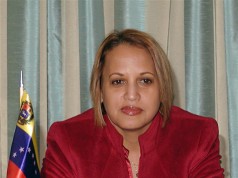LONDON — A horrific shooting rampage at a youth
summer camp left at least 80 people dead as Norway reeled from
apparently related terrorist attacks in a nation long known as the home
of the Nobel Peace Prize.
In addition to the shooting at a youth camp attended
by hundreds on the island of Utoya, a massive bomb exploded in downtown
Oslo, killing seven and injuring dozens.
Police director Oystein Maeland told reporters early
Saturday they had discovered many more victims after initially reporting
the death toll at 10, the Associated Press reported.
Maeland couldn’t say how many people were injured in the shooting.
The summer camp on Utoya, about 19 miles from Oslo,
was organized by the youth wing of Prime Minister Jens Stoltenberg’s
Labor Party.
According to the Associated Press, a suspect in the
shootings and the Oslo explosion was arrested. Though police did not
release his name, Norwegian national broadcaster NRK identified him as
32-year-old Anders Behring Breivik and said police searched his Oslo
apartment overnight. NRK and other Norwegian media posted pictures of
the blond, blue-eyed Norwegian.
National police chief Sveinung Sponheim told public
broadcaster NRK that the suspected gunman’s Internet postings “suggest
that he has some political traits directed toward the right, and
anti-Muslim views, but if that was a motivation for the actual act
remains to be seen.”
Earlier, speculation had swirled around both Islamic
militant groups and domestic right-wing extremists. Al-Qaida previously
has singled out Norway as a target, and a shadowy group affiliated with
the terrorist network reportedly claimed responsibility, a statement
that could not be verified.
But another police official said the suspect appears
to have acted alone in both attacks, and that “it seems like that this
is not linked to any international terrorist organizations at all.” The
official spoke on condition of anonymity because that information had
not been officially released by Norway’s police.
“It seems it’s not Islamic-terror related,” the official said. “This seems like a madman’s work.”
The official said the attack “is probably more
Norway’s Oklahoma City than it is Norway’s World Trade Center.” Domestic
terrorists carried out the 1995 attack on a federal building in
Oklahoma City, while foreign terrorists were responsible for the Sept.
11, 2001 attacks.
Friday’s double attacks, which police said were
linked, recalled the dramatic 2008 siege on a hotel and other sites in
Mumbai, India, that raised international fear of coordinated,
sophisticated attacks on “soft” targets unprepared for a large-scale
assault.
The rampage on Utoya, a small, heavily wooded island
not far from Oslo, was a particularly harsh blow. A youth convention of
the ruling Labor Party, the biggest political event of the summer, was
under way there. Hundreds of young people, some of them teenagers, were
in attendance.
Authorities say witnesses described the assailant as a
man dressed in a police uniform. The suspect, a 32-year-old Norwegian,
was arrested on Utoya. Police later found undetonated explosives on the
island.
The prime minister’s office was heavily damaged by
the bomb blast in Oslo, which killed seven people. Norwegian news
reports said that Prime Minister Jens Stoltenberg was working at another
location and was unharmed. In a nationally televised address, he urged
his compatriots not to be overcome by fear.
But the shock and scars from the violence will
probably run deep in the normally placid, close-knit Scandinavian nation
of about 5 million people. Authorities closed Norway’s borders shortly
after the attacks.
“Norway will stand together in a time of crisis,” Stoltenberg said.
Addressing the attackers, he said: “You will not
destroy our democracy and our ideals for a better world…. No one will
bomb us into silence; no one will shoot us into silence.”
At the White House, President Barack sent his
condolences to Oslo and called for stronger global cooperation to combat
terrorism.
———
(c) 2011, Los Angeles Times.
Visit the Los Angeles Times on the Internet at http://www.latimes.com/.
Distributed by McClatchy-Tribune Information Services.













